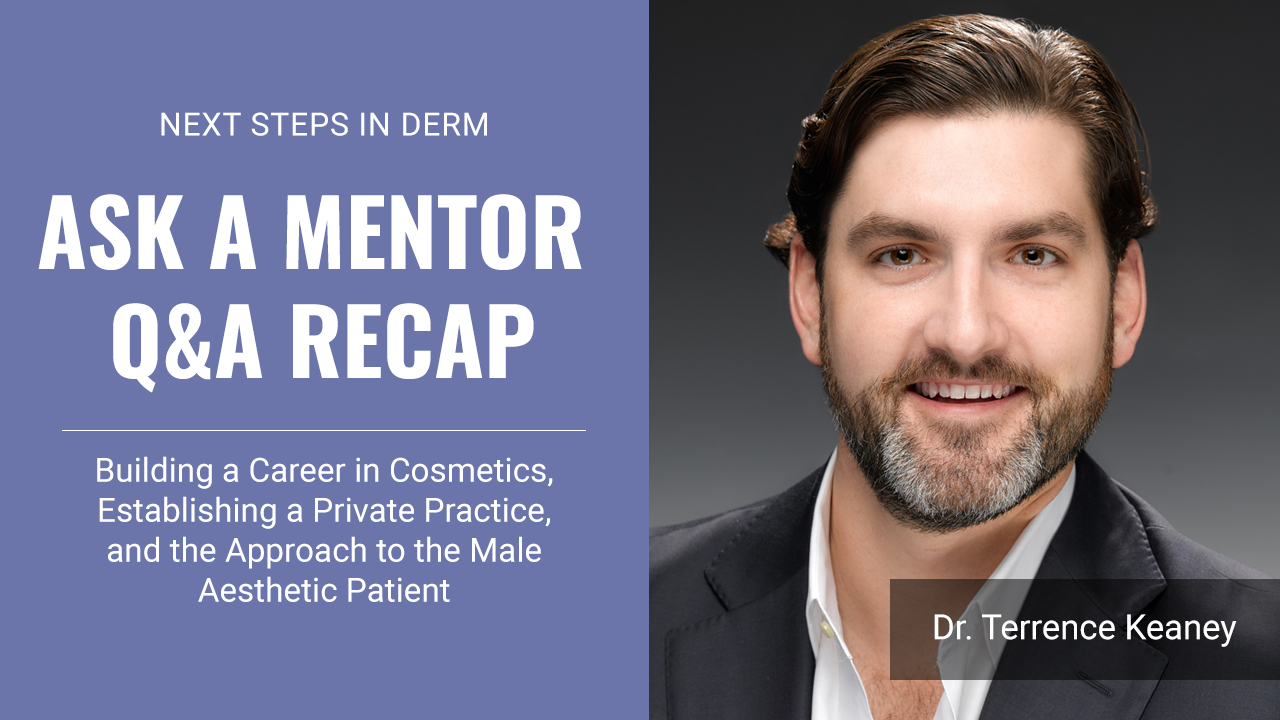Our Next Steps readers had the opportunity to ask Dr. Terrence Keaney questions on building a career in cosmetics, establishing a private practice, and the approach to the male aesthetic patient. See all his insightful answers below.
 How do you think men’s skincare needs are different than women? What is most common skincare concern that you see in your male patients? What do you think is the most common skincare product that men purchase?
How do you think men’s skincare needs are different than women? What is most common skincare concern that you see in your male patients? What do you think is the most common skincare product that men purchase?
Male skin is unique due to the effect of testosterone on skin function. Male facial skin produces more sebum, sweat, and terminal hairs. The gender difference in cutaneous physiology results in different tactile sensations and needs from skincare products between genders. In addition, a reduction in antioxidant capacity and poor sun protective behaviors in men contributes to their increase in skin cancer especially melanoma. Despite skin cancer being the #1 skin concern in men, sunscreen is not the most common skincare product that men use. Men, by far, use more grooming and shaving products than any other skincare category.
What post shaving advice to you give for your sensitive skin patients who get dermatitis, irritation or ingrown hairs after shaving?
I recommend that men shave either in the shower or immediately after showering so their beard hairs are hydrated and easier to cut with their shaving device. I also advise my male patients that the closer the shave; the bigger the potential problems. Men with shaving issues should use single blade or electric razors. If men still get “hair bumps” or pseudofolliculitis, I then recommend laser hair removal for a long-lasting reduction in hair without having to shave.
Are men under 35 more likely to use more products than men over 35 or where do you think that age cut off is? I seem to see that men 40 and under are more likely to want a more extensive skincare regimen while men over 40 want a multifunctional product. Do you see that too?
I agree that younger men are more likely to consider skincare and other aesthetic products/treatments. Younger men often are often using haircare products, beard oils, etc. so adding a skincare regimen is not a “big” deal to them.
Is volume loss different in men vs women? How do these differences translate in selecting the right injectable products? What are your top tips for avoiding feminization in male aesthetic patients seeking interventions?
Men lose volume at a similar rate then women. The difference is the distribution of facial volume. All men have less facial soft tissue and a large, square skull. The key to using dermal fillers is to use them to recreate or maintain the masculine facial shape/volume. Quick tips include avoiding overcorrection of the medial cheek or creating a high and lateral cheek apex.
I often find it difficult to bring up aesthetic treatments with my male patient base…can you share how you usually approach the subject with them?
I often identify features of facial aging just as I would diagnose a benign lesion on skin exam. I do not dwell on the diagnosis, but only mention that there are treatment options if it bothers them. If your male patient is interested, he will begin to ask questions.
I’m in the process of starting my own private practice and looking into laser devices to purchase but I’m finding the process overwhelming. How did you go about this when you started your own practice? What’s the best way to learn about all available options for lasers and finally be able to make a purchase decision?
Your patients dictate what devices that you need. Do not assume patients will show up if you have a laser. It may be worthwhile to start your practice before purchasing a laser, so you can determine which devices would best serve your patient mix.
If you had to describe the process of starting your own practice in 5 steps, what would those be?
- Know why and what you want from your own practice.
- Build a team (lawyer, accountants, architects, etc.) that you can trust and can guide you in the startup process
- Location, location, location! Be strategic in where you start your practice.
- Think short term and long term: Create both short term and long-term goals and financial projections.
- Develop your niche – This allows you to differentiate yourself from other dermatology practices in the area.
What is one book, aside from textbooks, you think all dermatologists should read?
When Breath becomes Air by Paul Kalanithi: Amazing and emotional book about life and death.
Are you enjoying our Ask a Mentor Series? Check out past mentor Q&A Recaps and by clicking here!

